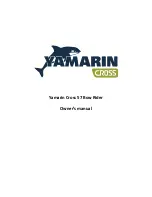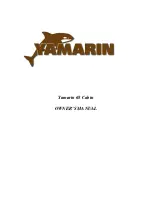
CHAPTER 2
SAFETY EQUIPMENT
- 9 -
34z
First Aid Kit
Not a place to scrimp. It is advisable to carry a good, comprehensive, and well-organized (by
injury) marine first-aid kit with manual. We recommend that it be stored in the head and that
everyone onboard be informed of its location. (Remember, you may be the one in need of it!)
Companionway Hatch Board or Closure
A teak board is provided with the label, “ DO NOT REMOVE WHILE UNDERWAY” to comply with
ISO requirements for cockpit draining and construction to prevent large waves from crashing
down into the cockpit, running forward into the pilothouse and entering the interior of the boat. It
would be far easier and more effective in rough weather – providing more effective full closure of
the companionway entrance – to simply close and latch the companionway slider, which has the
capability to open from either on deck or from inside should someone be below.
2.2
FUEL SHUT-OFF VALVES
The fuel shut-off valves are located on top of the fuel tanks and are accessible through pilothouse
settee lockers. Make sure you know how to shut off the fuel valve. (When the handle is
perpendicular to the hose, the valve is closed.) In case of a fuel fire, STOP any machinery and
close the valve to cut the supply of fuel to the fire/engine. If you should ever see fuel in the bilges,
turn off the valve, clean the bilges, and find the source of the leak immediately. Also note that
there are fuel shut off valves, normally left open, on the lower inboard aft corner of the fuel tanks,
which connect the two tanks together at the bottom for self-leveling. There is only one fuel level
sensor and that is on the starboard tank.
2.3 FIRE
Fire aboard a boat is a serious matter, and fire safety begins with fire prevention. You can reduce
the risk of fire by following common sense guidelines:
Do not allow debris or oily rags to collect in bilges or machinery spaces.
Understand your electrical system, allow only qualified marine electricians to work on it, and shut
down as many circuits as practical when leaving the boat. Do not leave appliances running while
unattended.
Have your fire suppression equipment inspected regularly and learn how to use it.
An automatic fire suppression system is installed on every boat in the engine space. It is heat
activated. Read the information that comes with the equipment. The system can also be manually
activated at the helm station. [
See Helm Console Section
]
Because a diesel engine would
evacuate the suppression agent from the affected space, the system will shut down the engine
(and generator) when it discharges. If manually activating the system, the engine should be shut
down first. After the situation has stabilized, the shut-down feature can be over-ridden to restart
the engine. A loud warning alarm will sound when the system has been activated.
The hand-held fire extinguisher mounted outboard of the starboard helm seat is rated to fight type
A, B & C fires.
To extinguish a fire, the most effective method is to cut the source of fuel to the fire. In the case of
a diesel fuel fire, the fuel tank valves should be closed. In the case of an electrical fire, the main
battery switches or main disconnect breakers should be turned off. Fire needs oxygen to burn, so
if a fire should occur in an enclosed area, the best course of action may be to exit the area and
seal it from the outside by closing all means of air intake










































